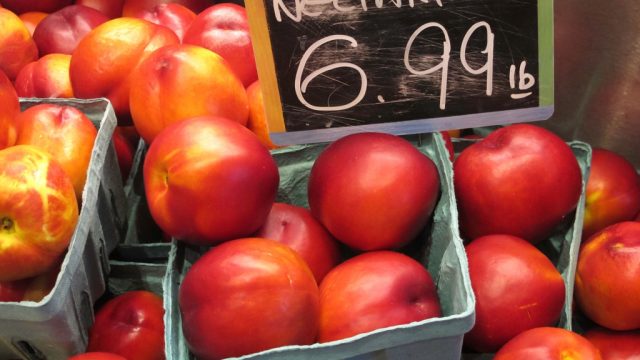This Is Why Prices Always End in "99 Cents"
The big psychology of dropping a tiny penny

It's such a familiar sales tactic that you'd think we eagle-eyed shoppers would have seen through it by now. Yet as sure as a sign promising a "SALE" catches our eyes, price tags ending in 99 cents still make us think—unconsciously or not—that we're getting a better deal than a round number. It all begs the question: Why?!
Well, a little bit of history is in order.
Though it's unclear who first came up with this pricing idea, it gained popularity in the late 19th century, as newspaper advertising exploded and retailers sought ways to compete with one another on price. As researcher and The Straight Dope author Cecil Adams explains, "At first prices were usually rounded off to the nickel, dime, or dollar, but it wasn't long before a few smaller operators looking for an edge began using what might be called 'just under' pricing (49 cents, $1.95, and so on), no doubt in an effort to convince the gullible they were getting a bargain."
And it worked.
As retailers saw the success of this approach, the "just under" pricing became standard. A recent survey published by Marketing Bulletin found that about 60% of advertised prices ended in the number 9, while 30 percent ended in 5 and just 7 percent ended in 0.
Psychology has since caught up with what retailers figured out decades before: "For one penny, I can get you to think of it differently," as Mark Bergen, a Professor at Carlson School of Management at the University of Minnesota explained to an ABC affiliate. "If price matters, I can get you to entertain our product."
It comes down to what's called "psychological pricing"—that certain prices can create a greater psychological impact than just the actual value that they represent. Among the theories under this approach is the "left-digit effect"—that we focus on the left-most digit in a price rather than the pennies on the other side. For example, a 2005 study asked subjects how much they believed they could buy with $73 and were presented with products bearing prices ending in ".00," then with products bearing "charm prices" ending with ".99." Across the board, subjects believed they could buy more when the prices ended in ".99."
Another explanation is "prospect theory," which holds that shoppers make a decision based on potential losses or gains rather than a product's absolute value—so they see a price in relative terms. That means a product that costs $9.99 is unconsciously compared to a "reference price" of $10, so we interpret it as some kind of discount and feel that we're getting a good deal.
But charm prices work not just when they are lower than the alternative—say $2.99 compared to $3.00. They have also been found to inspire purchases when they are slightly more than the alternative. In a study that compared purchasing behavior between shirts costing $34, $39 and $44, the shirts selling for $39 sold better than both those selling for $44 and $34.
Or consumers simply overlook the digits representing smaller values and care more about the dollars. Keith Coulter, associate professor of marketing at the Graduate School of Management, Clark University, points out that this effect is enhanced when the cents (or, in the case of gas prices, the fractions of cents) are put in a smaller font.
More than likely, we're responding to a combination of all these factors. And while some of us might have outsmarted the marketers who capitalize on these deep-seated responses and know that $9.99 is just 10 bucks, the vast majority of us can't help ourselves or our psychological responses. So we're going to see prices ending in "99" for a long time coming. And for more ways retailers know your innermost thoughts and behaviors, don't miss these 23 Clever Ways Retailers Always Trick You.
To discover more amazing secrets about living your best life, click here to sign up for our FREE daily newsletter!





















